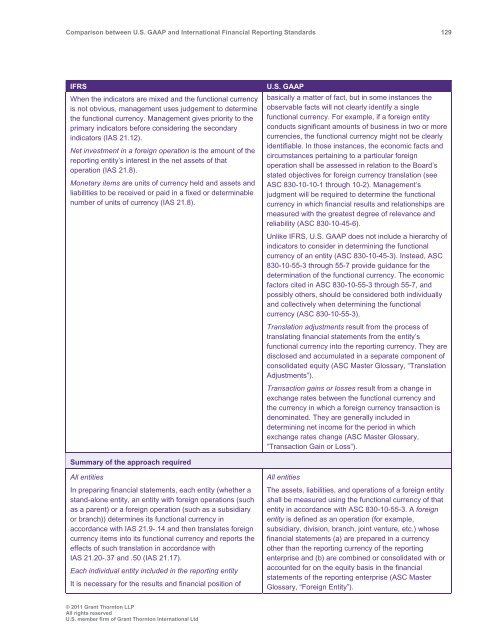Comparison between U.S. GAAP and International ... - Grant Thornton
Comparison between U.S. GAAP and International ... - Grant Thornton
Comparison between U.S. GAAP and International ... - Grant Thornton
Create successful ePaper yourself
Turn your PDF publications into a flip-book with our unique Google optimized e-Paper software.
<strong>Comparison</strong> <strong>between</strong> U.S. <strong>GAAP</strong> <strong>and</strong> <strong>International</strong> Financial Reporting St<strong>and</strong>ards 129<br />
IFRS<br />
When the indicators are mixed <strong>and</strong> the functional currency<br />
is not obvious, management uses judgement to determine<br />
the functional currency. Management gives priority to the<br />
primary indicators before considering the secondary<br />
indicators (IAS 21.12).<br />
Net investment in a foreign operation is the amount of the<br />
reporting entity’s interest in the net assets of that<br />
operation (IAS 21.8).<br />
Monetary items are units of currency held <strong>and</strong> assets <strong>and</strong><br />
liabilities to be received or paid in a fixed or determinable<br />
number of units of currency (IAS 21.8).<br />
U.S. <strong>GAAP</strong><br />
basically a matter of fact, but in some instances the<br />
observable facts will not clearly identify a single<br />
functional currency. For example, if a foreign entity<br />
conducts significant amounts of business in two or more<br />
currencies, the functional currency might not be clearly<br />
identifiable. In those instances, the economic facts <strong>and</strong><br />
circumstances pertaining to a particular foreign<br />
operation shall be assessed in relation to the Board’s<br />
stated objectives for foreign currency translation (see<br />
ASC 830-10-10-1 through 10-2). Management’s<br />
judgment will be required to determine the functional<br />
currency in which financial results <strong>and</strong> relationships are<br />
measured with the greatest degree of relevance <strong>and</strong><br />
reliability (ASC 830-10-45-6).<br />
Unlike IFRS, U.S. <strong>GAAP</strong> does not include a hierarchy of<br />
indicators to consider in determining the functional<br />
currency of an entity (ASC 830-10-45-3). Instead, ASC<br />
830-10-55-3 through 55-7 provide guidance for the<br />
determination of the functional currency. The economic<br />
factors cited in ASC 830-10-55-3 through 55-7, <strong>and</strong><br />
possibly others, should be considered both individually<br />
<strong>and</strong> collectively when determining the functional<br />
currency (ASC 830-10-55-3).<br />
Translation adjustments result from the process of<br />
translating financial statements from the entity’s<br />
functional currency into the reporting currency. They are<br />
disclosed <strong>and</strong> accumulated in a separate component of<br />
consolidated equity (ASC Master Glossary, “Translation<br />
Adjustments”).<br />
Transaction gains or losses result from a change in<br />
exchange rates <strong>between</strong> the functional currency <strong>and</strong><br />
the currency in which a foreign currency transaction is<br />
denominated. They are generally included in<br />
determining net income for the period in which<br />
exchange rates change (ASC Master Glossary,<br />
“Transaction Gain or Loss”).<br />
Summary of the approach required<br />
All entities<br />
In preparing financial statements, each entity (whether a<br />
st<strong>and</strong>-alone entity, an entity with foreign operations (such<br />
as a parent) or a foreign operation (such as a subsidiary<br />
or branch)) determines its functional currency in<br />
accordance with IAS 21.9-.14 <strong>and</strong> then translates foreign<br />
currency items into its functional currency <strong>and</strong> reports the<br />
effects of such translation in accordance with<br />
IAS 21.20-.37 <strong>and</strong> .50 (IAS 21.17).<br />
Each individual entity included in the reporting entity<br />
It is necessary for the results <strong>and</strong> financial position of<br />
All entities<br />
The assets, liabilities, <strong>and</strong> operations of a foreign entity<br />
shall be measured using the functional currency of that<br />
entity in accordance with ASC 830-10-55-3. A foreign<br />
entity is defined as an operation (for example,<br />
subsidiary, division, branch, joint venture, etc.) whose<br />
financial statements (a) are prepared in a currency<br />
other than the reporting currency of the reporting<br />
enterprise <strong>and</strong> (b) are combined or consolidated with or<br />
accounted for on the equity basis in the financial<br />
statements of the reporting enterprise (ASC Master<br />
Glossary, “Foreign Entity”).<br />
© 2011 <strong>Grant</strong> <strong>Thornton</strong> LLP<br />
All rights reserved<br />
U.S. member firm of <strong>Grant</strong> <strong>Thornton</strong> <strong>International</strong> Ltd
















